Research on the Spatiotemporal Evolution Characteristics and Driving Factors of Cropland in Tanzania from 1990 to 2020
Abstract
1. Introduction
2. Materials and Methods
2.1. Overview of the Study Area
2.2. Data Source and Processing
2.3. Research Method
2.3.1. Land Use Transfer Matrix
2.3.2. Hotspot Analysis
2.3.3. Standard Deviation Ellipse Analysis
2.3.4. Geographic Detector
3. Results
3.1. Overall Situation of Cropland Changes
3.1.1. Changes in Cropland Area
3.1.2. Transformation of Cropland
3.2. Distribution and Spatiotemporal Evolution of Cropland
3.2.1. Overall Distribution of Cropland
3.2.2. Hotspot Analysis of Cropland Changes
3.2.3. Distribution Direction and Center of Cropland
3.3. Causes of Spatial Differentiation of Cropland
4. Discussion
4.1. Alignment and Differentiation with Agricultural Development Theory
4.2. Stage Effect and Regional Differences of Policy Intervention
4.3. Dynamic Balance Driven by Nature and Socioeconomic Factors
4.4. Sustainability Challenges and Policy Implications of Agricultural Transformation
4.5. Limitations of the Research
5. Conclusions
Author Contributions
Funding
Data Availability Statement
Conflicts of Interest
Abbreviations
| GDP | Gross Domestic Product |
| GIS | Geographic Information System |
| RS | Remote Sensing |
| SRTM | Shuttle Radar Topography Mission |
| GHSL | Global Human Settlement Layer |
References
- Pawlak, K.; Kolodziejczak, M. The Role of Agriculture in Ensuring Food Security in Developing Countries: Considerations in the Context of the Problem of Sustainable Food Production. Sustainability 2020, 12, 5488. [Google Scholar] [CrossRef]
- Simane, B.; Kapwata, T.; Naidoo, N.; Cisse, G.; Wright, C.Y.; Berhane, K. Ensuring Africa’s Food Security by 2050: The Role of Population Growth, Climate-Resilient Strategies, and Putative Pathways to Resilience. Foods 2025, 14, 262. [Google Scholar] [CrossRef]
- Akinyemi, F.O.; Speranza, C.I. Agricultural Landscape Change Impact on the Quality of Land: An African Continent-Wide Assessment in Gained and Displaced Agricultural Lands. Int. J. Appl. Earth Obs. Geoinf. 2022, 106, 102644. [Google Scholar] [CrossRef]
- Li, H.; Song, W. Spatial Transformation of Changes in Global Cultivated Land. Sci. Total Environ. 2023, 859, 160194. [Google Scholar] [CrossRef] [PubMed]
- Song, F.; Wang, S.; Bai, X.; Wu, L.; Wang, J.; Li, C.; Chen, H.; Luo, X.; Xi, H.; Zhang, S.; et al. A New Indicator for Global Food Security Assessment: Harvested Area Rather than Cropland Area. Chin. Geogr. Sci. 2022, 32, 204–217. [Google Scholar] [CrossRef]
- Zhang, Q.; Sannigrahi, S.; Bilintoh, T.M.; Zhang, R.; Xiong, B.; Tao, S.; Bilsborrow, R.; Song, C. Understanding Human-Environment Interrelationships under Constrained Land-Use Decisions with a Spatially Explicit Agent-Based Model. Anthropocene 2022, 38, 100337. [Google Scholar] [CrossRef]
- Radocaj, D.; Jurisic, M. GIS-Based Cropland Suitability Prediction Using Machine Learning: A Novel Approach to Sustainable Agricultural Production. Agronomy 2022, 12, 2210. [Google Scholar] [CrossRef]
- Li, R.; Wei, C.; Afroz, M.D.; Lyu, J.; Chen, G. A GIS-Based Framework for Local Agricultural Decision-Making and Regional Crop Yield Simulation. Agric. Syst. 2021, 193, 103213. [Google Scholar] [CrossRef]
- Gao, H.; Gong, J.; Ye, T.; Maier, M.; Liu, J. Constructing Cropland Ecological Stability Assessment Method Based on Disturbance-Resistance-Response Processes and Classifying Cropland Ecological Types. Sci. Total Environ. 2024, 930, 172673. [Google Scholar] [CrossRef]
- Kuang, W.; Liu, J.; Tian, H.; Shi, H.; Dong, J.; Song, C.; Li, X.; Du, G.; Hou, Y.; Lu, D.; et al. Cropland Redistribution to Marginal Lands Undermines Environmental Sustainability. Natl. Sci. Rev. 2022, 9, nwab091. [Google Scholar] [CrossRef]
- Potapov, P.; Turubanova, S.; Hansen, M.C.; Tyukavina, A.; Zalles, V.; Khan, A.; Song, X.-P.; Pickens, A.; Shen, Q.; Cortez, J. Global Maps of Cropland Extent and Change Show Accelerated Cropland Expansion in the Twenty-First Century. Nat. Food 2022, 3, 19–28. [Google Scholar] [CrossRef]
- Li, X.; Wu, K.; Hao, S.; Yue, Z.; Ran, Z.; Ma, J. Mapping Cropland Suitability in China Using Optimized MaxEnt Model. Field Crops Res. 2023, 302, 109064. [Google Scholar] [CrossRef]
- Lark, T.J.; Schelly, I.H.; Gibbs, H.K. Accuracy, Bias, and Improvements in Mapping Crops and Cropland across the United States Using the USDA Cropland Data Layer. Remote Sens. 2021, 13, 968. [Google Scholar] [CrossRef]
- Tariq, A.; Yan, J.; Gagnon, A.S.; Khan, M.R.; Mumtaz, F. Mapping of Cropland, Cropping Patterns and Crop Types by Combining Optical Remote Sensing Images with Decision Tree Classifier and Random Forest. Geo Spat. Inf. Sci. 2023, 26, 302–320. [Google Scholar] [CrossRef]
- Bullock, E.L.; Healey, S.P.; Yang, Z.; Oduor, P.; Gorelick, N.; Omondi, S.; Ouko, E.; Cohen, W.B. Three Decades of Land Cover Change in East Africa. Land 2021, 10, 150. [Google Scholar] [CrossRef]
- Omuto, C.T.; Kome, G.K.; Ramakhanna, S.J.; Muzira, N.M.; Ruley, J.A.; Jayeoba, O.J.; Raharimanana, V.; Ansah, A.O.; Khamis, N.A.; Mathafeng, K.K.; et al. Trend of Soil Salinization in Africa and Implications for Agro-Chemical Use in Semi-Arid Croplands. Sci. Total Environ. 2024, 951, 175503. [Google Scholar] [CrossRef]
- Chen, C.; Dong, T.; Wang, Z.; Wang, C.; Song, W.; Zhang, H. Exploring Optimal Features and Image Analysis Methods for Crop Type Classification from the Perspective of Crop Landscape Heterogeneity. Remote Sens. Appl. Soc. Environ. 2024, 36, 101308. [Google Scholar] [CrossRef]
- Bofana, J.; Zhang, M.; Nabil, M.; Wu, B.; Tian, F.; Liu, W.; Zeng, H.; Zhang, N.; Nangombe, S.S.; Cipriano, S.A.; et al. Comparison of Different Cropland Classification Methods under Diversified Agroecological Conditions in the Zambezi River Basin. Remote Sens. 2020, 12, 2096. [Google Scholar] [CrossRef]
- Tian, G.; Duan, J.; Yang, L. Spatio-Temporal Pattern and Driving Mechanisms of Cropland Circulation in China. Land Use Policy 2021, 100, 105118. [Google Scholar] [CrossRef]
- Luo, L.; Li, Y.; Ma, W.; Rong, J.; Wei, J.; Cui, Y.; Qu, T. Temporal-Spatial Dynamics and Collaborative Effects of Cropland Resilience in China. Land 2025, 14, 108. [Google Scholar] [CrossRef]
- Wang, M.; Wang, C.; Hu, Q.; Wei, H.; Li, X.; Li, Z.; Zhu, N.; Xue, B.; Li, S.; Xu, B. Spatial-Temporal Patterns of Cultivated Land Expansion and Intensification in Africa from 2000 to 2020. Int. J. Agric. Sustain. 2025, 23, 2476220. [Google Scholar] [CrossRef]
- Hu, X.; Dong, C.; Zhang, Y. Impacts of Cropland Utilization Patterns on the Sustainable Use Efficiency of Cropland Based on the Human-Land Perspective. Land 2024, 13, 863. [Google Scholar] [CrossRef]
- Nelson, K.S.; Burchfield, E.K. Landscape Complexity and US Crop Production. Nat. Food 2021, 2, 330–338. [Google Scholar] [CrossRef]
- Nabil, M.; Zhang, M.; Bofana, J.; Wu, B.; Stein, A.; Dong, T.; Zeng, H.; Shang, J. Assessing Factors Impacting the Spatial Discrepancy of Remote Sensing Based Cropland Products: A Case Study in Africa. Int. J. Appl. Earth Obs. Geoinf. 2020, 85, 102010. [Google Scholar] [CrossRef]
- Nzabarinda, V.; Bao, A.; Xu, W.; Uwamahoro, S.; Huang, X.; Gao, Z.; Umugwaneza, A.; Kayumba, P.M.; Maniraho, A.P.; Jiang, Z. Impact of Cropland Development Intensity and Expansion on Natural Vegetation in Different African Countries. Ecol. Inf. 2021, 64, 101359. [Google Scholar] [CrossRef]
- Nzunda, E.F.; Midtgaard, F. Deforestation and Loss of Bushland and Grassland Primarily Due to Expansion of Cultivation in Mainland Tanzania (1995–2010). J. Sustain. For. 2019, 38, 509–525. [Google Scholar] [CrossRef]
- Doggart, N.; Morgan-Brown, T.; Lyimo, E.; Mbilinyi, B.; Meshack, C.K.; Sallu, S.M.; Spracklen, D.V. Agriculture Is the Main Driver of Deforestation in Tanzania. Environ. Res. Lett. 2020, 15, 034028. [Google Scholar] [CrossRef]
- Kennedy, J.; Hurtt, G.C.; Liang, X.-Z.; Chini, L.; Ma, L. Changing Cropland in Changing Climates: Quantifying Two Decades of Global Cropland Changes. Environ. Res. Lett. 2023, 18, 064010. [Google Scholar] [CrossRef]
- Zhai, J.; Xiao, C.; Feng, Z.; Liu, Y. Spatio-Temporal Patterns of Land-Use Changes and Conflicts between Cropland and Forest in the Mekong River Basin during 1990–2020. Land 2022, 11, 927. [Google Scholar] [CrossRef]
- Zhong, H.; Liu, Z.; Wang, J. Understanding Impacts of Cropland Pattern Dynamics on Grain Production in China: A Integrated Analysis by Fusing Statistical Data and Satellite-Observed Data. J. Environ. Manag. 2022, 313, 114988. [Google Scholar] [CrossRef]
- Khan, S.N.; Li, D.; Maimaitijiang, M. A Geographically Weighted Random Forest Approach to Predict Corn Yield in the US Corn Belt. Remote Sens. 2022, 14, 2843. [Google Scholar] [CrossRef]
- Zhao, Y.; Feng, Q. Identifying Spatial and Temporal Dynamics and Driving Factors of Cultivated Land Fragmentation in Shaanxi Province. Agric. Syst. 2024, 217, 103948. [Google Scholar] [CrossRef]
- Ojara, M.A.; Lou, Y.; Babaousmail, H.; Sempa, A.K.; Ayugi, B.; Ogwang, B.A. Evaluation of Drought, Wet Events, and Climate Variability Impacts on Maize Crop Yields in East Africa during 1981–2017. Int. J. Plant Prod. 2022, 16, 41–62. [Google Scholar] [CrossRef]
- Choi, Y.-W.; Eltahir, E.A.B. Near-Term Climate Change Impacts on Food Crops Productivity in East Africa. Theor. Appl. Climatol. 2023, 152, 843–860. [Google Scholar] [CrossRef]
- Li, X.; Zhang, X.; Jin, X. Spatio-Temporal Characteristics and Driving Factors of Cultivated Land Change in Various Agricultural Regions of China: A Detailed Analysis Based on County-Level Data. Ecol. Indic. 2024, 166, 112485. [Google Scholar] [CrossRef]
- Zhang, B.; Li, W.; Zhang, C. Analyzing Land Use and Land Cover Change Patterns and Population Dynamics of Fast-Growing US Cities: Evidence from Collin County, Texas. Remote Sens. Appl. Soc. Environ. 2022, 27, 100804. [Google Scholar] [CrossRef]
- Mao, C.; Feng, S.; Zhou, C. Cropland Loss under Different Urban Expansion Patterns in China (1990–2020): Spatiotemporal Characteristics, Driving Factors, and Policy Implications. Land 2025, 14, 343. [Google Scholar] [CrossRef]
- Huang, Q.; Liu, Z.; He, C.; Gou, S.; Bai, Y.; Wang, Y.; Shen, M. The Occupation of Cropland by Global Urban Expansion from 1992 to 2016 and Its Implications. Environ. Res. Lett. 2020, 15, 084037. [Google Scholar] [CrossRef]
- Polizel, S.P.; Vieira, R.M.d.S.P.; Pompeu, J.; Ferreira, Y.d.C.; Sousa-Neto, E.R.d.; Barbosa, A.A.; Balbaud, J.P.H. Analysing the Dynamics of Land Use in the Context of Current Conservation Policies and Land Tenure in the Cerrado-MATOPIBA Region (Brazil). Land Use Policy 2021, 109, 105713. [Google Scholar] [CrossRef]
- Dramstad, W.E.; Sang, N.; Forsberg-Mathiesen, H.; Bryn, A. Five Ways of Characterizing Agricultural Land Use Dynamics and Abandonment from Subsidy Data. Land 2021, 10, 1136. [Google Scholar] [CrossRef]
- Belair, J. Farmland Investments in Tanzania: The Impact of Protected Domestic Markets and Patronage Relations. World Dev. 2021, 139, 105298. [Google Scholar] [CrossRef]
- Uisso, A.M.; Tanrivermis, H. Driving Factors and Assessment of Changes in the Use of Arable Land in Tanzania. Land Use Policy 2021, 104, 105359. [Google Scholar] [CrossRef]
- Jones, K.; Nowak, A.; Berglund, E.; Grinnell, W.; Temu, E.; Paul, B.; Renwick, L.L.R.; Steward, P.; Rosenstock, T.S.; Kimaro, A.A. Evidence Supports the Potential for Climate-Smart Agriculture in Tanzania. Glob. Food Secur. Agric. Policy 2023, 36, 100666. [Google Scholar] [CrossRef]
- Sigalla, O.Z.; Valimba, P.; Selemani, J.R.; Kashaigili, J.J.; Tumbo, M. Analysis of Spatial and Temporal Trend of Hydro-Climatic Parameters in the Kilombero River Catchment, Tanzania. Sci. Rep. 2023, 13, 7864. [Google Scholar] [CrossRef] [PubMed]
- Wineman, A.; Jayne, T.S.; Modamba, E.I.; Kray, H. The Changing Face of Agriculture in Tanzania: Indicators of Transformation. Dev. Policy Rev. 2020, 38, 685–709. [Google Scholar] [CrossRef]
- Liu, L.; Zhang, X.; Chen, X.; Gao, Y.; Mi, J. GLC_FCS30-2020:Global Land Cover with Fine Classification System at 30m in 2020; Institute of Aerospace Information Innovation, Chinese Academy of Sciences: Beijing, China, 2020. [Google Scholar]
- Li, C.; Wu, J. Land Use Transformation and Eco-Environmental Effects Based on Production-Living-Ecological Spatial Synergy: Evidence from Shaanxi Province, China. Environ. Sci. Pollut. Res. 2022, 29, 41492–41504. [Google Scholar] [CrossRef] [PubMed]
- Kucukpehlivan, T.; Cetin, M.; Aksoy, T.; Kurkcuoglu, M.A.S.; Cabuk, S.N.; Pekkan, O.I.; Dabanli, A.; Cabuk, A. Determination of the Impacts of Urban-Planning of the Urban Land Area Using GIS Hotspot Analysis. Comput. Electron. Agric. 2023, 210, 107935. [Google Scholar] [CrossRef]
- Zhao, Y.; Wu, Q.; Wei, P.; Zhao, H.; Zhang, X.; Pang, C. Explore the Mitigation Mechanism of Urban Thermal Environment by Integrating Geographic Detector and Standard Deviation Ellipse (SDE). Remote Sens. 2022, 14, 3411. [Google Scholar] [CrossRef]
- Zhang, Z.; Song, Y.; Wu, P. Robust Geographical Detector. Int. J. Appl. Earth Obs. Geoinf. 2022, 109, 102782. [Google Scholar] [CrossRef]
- Zhang, J.; Zhang, R.; Fan, J.; Guan, X.; Liang, H. Spatiotemporal Dynamics of Urban and Rural Settlements in Tanzania (1975–2020): Drivers, Patterns, and Regional Disparities. Land 2025, 14, 1205. [Google Scholar] [CrossRef]
- Kirui, O.K.; Kornher, L.; Beckchanov, M. Productivity Growth and the Role of Mechanisation in African Agriculture. Agrekon 2023, 62, 80–97. [Google Scholar] [CrossRef]
- Csikos, N.; Toth, G. Concepts of Agricultural Marginal Lands and Their Utilisation: A Review. Agric. Syst. 2023, 204, 103560. [Google Scholar] [CrossRef]
- Maru, M.; Assen, M.; Mekuriaw, A.; Alemayehu, A. Land Use/Cover Dynamics and Its Implication in Alwero Watershed, Western Ethiopia. Proc. Natl. Acad. Sci. India A Phys. Sci. 2023, 93, 377–389. [Google Scholar] [CrossRef]
- Kanda, E.K.; Lutta, V.O. The Status and Challenges of a Modern Irrigation System in Kenya: A Systematic Review. Irrig. Drain. 2022, 71, 27–38. [Google Scholar] [CrossRef]
- Ke, X.; Chen, J.; Zuo, C.; Wang, X. The Cropland Intensive Utilisation Transition in China: An Induced Factor Substitution Perspective. Land Use Policy 2024, 141, 107128. [Google Scholar] [CrossRef]
- Ustaoglu, E.; Williams, B. Institutional Settings and Effects on Agricultural Land Conversion: A Global and Spatial Analysis of European Regions. Land 2023, 12, 47. [Google Scholar] [CrossRef]
- Darko, R.O.; Liu, J.; Yuan, S.; Sam-Amoah, L.K.; Yan, H. Irrigated Agriculture for Food Self-Sufficiency in the Sub-Saharan African Region. Int. J. Agric. Biol. Eng. 2020, 13, 1–12. [Google Scholar] [CrossRef]
- Hamududu, B.H.; Ngoma, H. Impacts of Climate Change on Water Resources Availability in Zambia: Implications for Irrigation Development. Environ. Dev. Sustain. 2020, 22, 2817–2838. [Google Scholar] [CrossRef]
- Forkuor, D.; Korah, A. NGOs and Sustainable Rural Development: Experience from Upper West Region of Ghana. Environ. Dev. Sustain. 2023, 25, 351–374. [Google Scholar] [CrossRef]
- Ononogbo, C.; Ohwofadjeke, P.O.; Chukwu, M.M.; Nwawuike, N.; Obinduka, F.; Nwosu, O.U.; Ugenyi, A.U.; Nzeh, I.C.; Nwosu, E.C.; Nwakuba, N.R.; et al. Agricultural and Environmental Sustainability in Nigeria: A Review of Challenges and Possible Eco-Friendly Remedies. Environ. Dev. Sustain. 2024, 26, 1–47. [Google Scholar] [CrossRef]
- Wanyama, J.; Bwambale, E.; Nakawuka, P. Comparative Performance Assessment of Pilot Irrigation Schemes in Uganda. Heliyon 2024, 10, e31600. [Google Scholar] [CrossRef]
- Zhang, J.; Chen, S.S.; Gao, Q.; Shen, Q.; Kimirei, I.A.; Mapunda, D.W. Morphological Characteristics of Informal Settlements and Strategic Suggestions for Urban Sustainable Development in Tanzania: Dar Es Salaam, Mwanza, and Kigoma. Sustainability 2020, 12, 3807. [Google Scholar] [CrossRef]
- Waldeck, L.; Holloway, J.; Van Heerden, Q. Integrated Land Use and Transportation Modelling and Planning: A South African Journey. J. Transp. Land Use 2020, 13, 227–254. [Google Scholar] [CrossRef]
- Fuglie, K.; Dhehibi, B.; El Shahat, A.A.I.; Aw-Hassan, A. Water, Policy, and Productivity in Egyptian AgricultureJEL Codes. Am. J. Agric. Econ. 2021, 103, 1378–1397. [Google Scholar] [CrossRef]
- Kogo, B.K.; Kumar, L.; Koech, R. Climate Change and Variability in Kenya: A Review of Impacts on Agriculture and Food Security. Environ. Dev. Sustain. 2021, 23, 23–43. [Google Scholar] [CrossRef]
- Hufkens, K.; de Haulleville, T.; Kearsley, E.; Jacobsen, K.; Beeckman, H.; Stoffelen, P.; Vandelook, F.; Meeus, S.; Amara, M.; Van Hirtum, L.; et al. Historical Aerial Surveys Map Long-Term Changes of Forest Cover and Structure in the Central Congo Basin. Remote Sens. 2020, 12, 638. [Google Scholar] [CrossRef]
- Gebrehiwot, T.; van der Veen, A. Farmers’ Drought Experience, Risk Perceptions, and Behavioural Intentions for Adaptation: Evidence from Ethiopia. Clim. Dev. 2021, 13, 493–502. [Google Scholar] [CrossRef]
- Li, C.; Kandel, M.; Anghileri, D.; Oloo, F.; Kambombe, O.; Chibarabada, T.P.; Ngongondo, C.; Sheffield, J.; Dash, J. Recent Changes in Cropland Area and Productivity Indicate Unsustainable Cropland Expansion in Malawi. Environ. Res. Lett. 2021, 16, 084052. [Google Scholar] [CrossRef]
- Bationo, L.J.; Diallo, A.; Topan, G.J. Heterogeneous and Average Effects of the Adoption of Sustainable Agricultural Practices on the Dietary Diversity of Smallholder Farmers in Burkina Faso. Food Energy Secur. 2025, 14, e70069. [Google Scholar] [CrossRef]


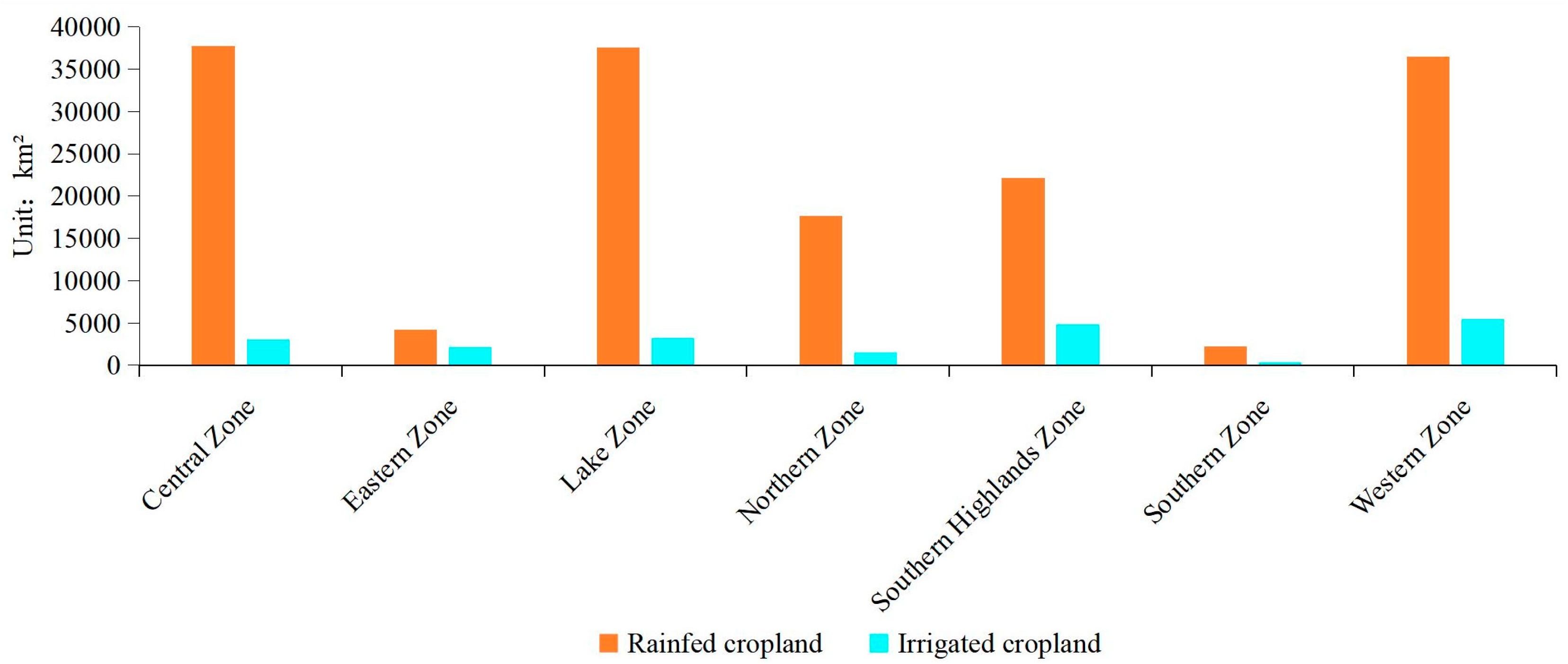

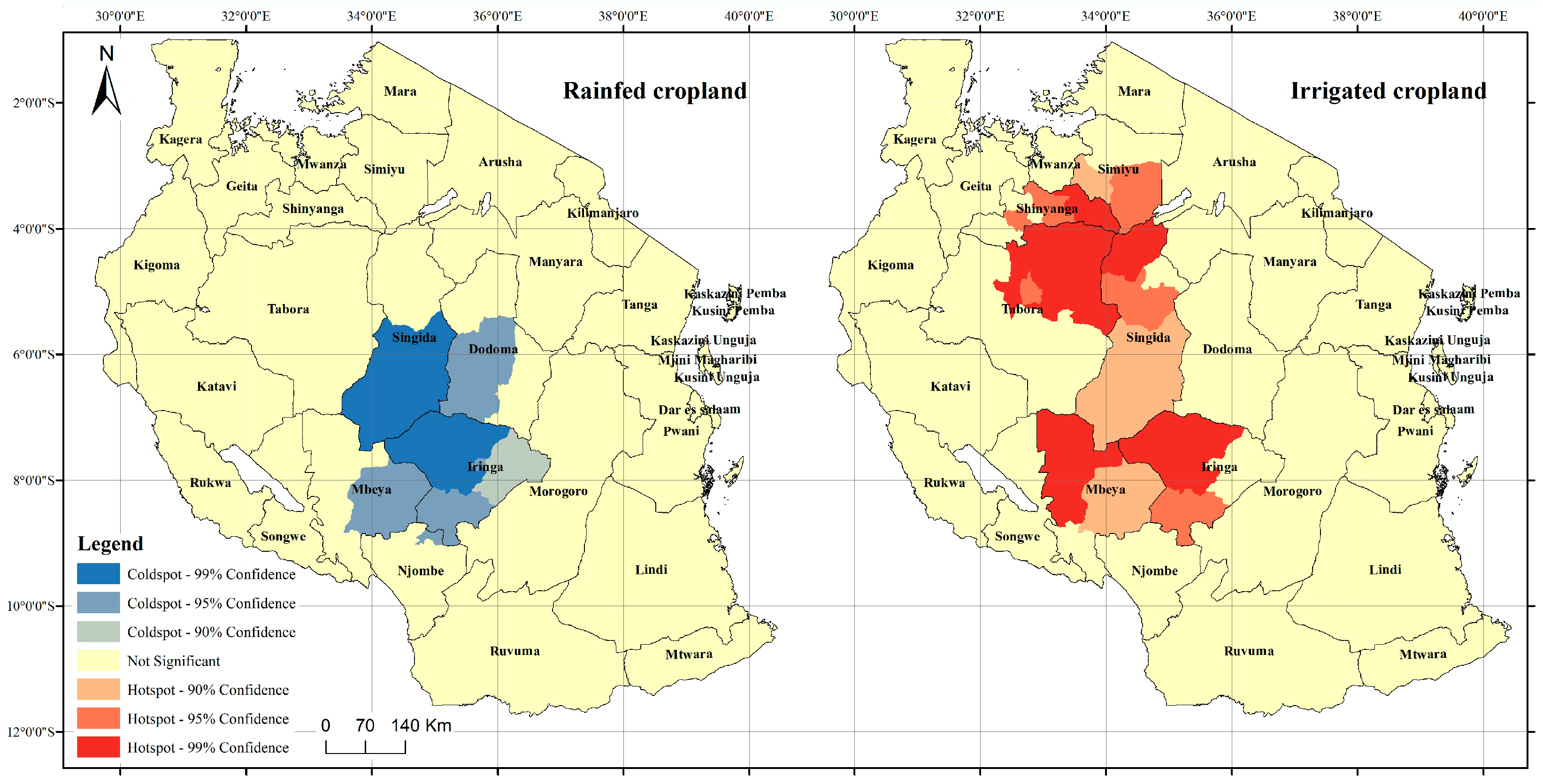
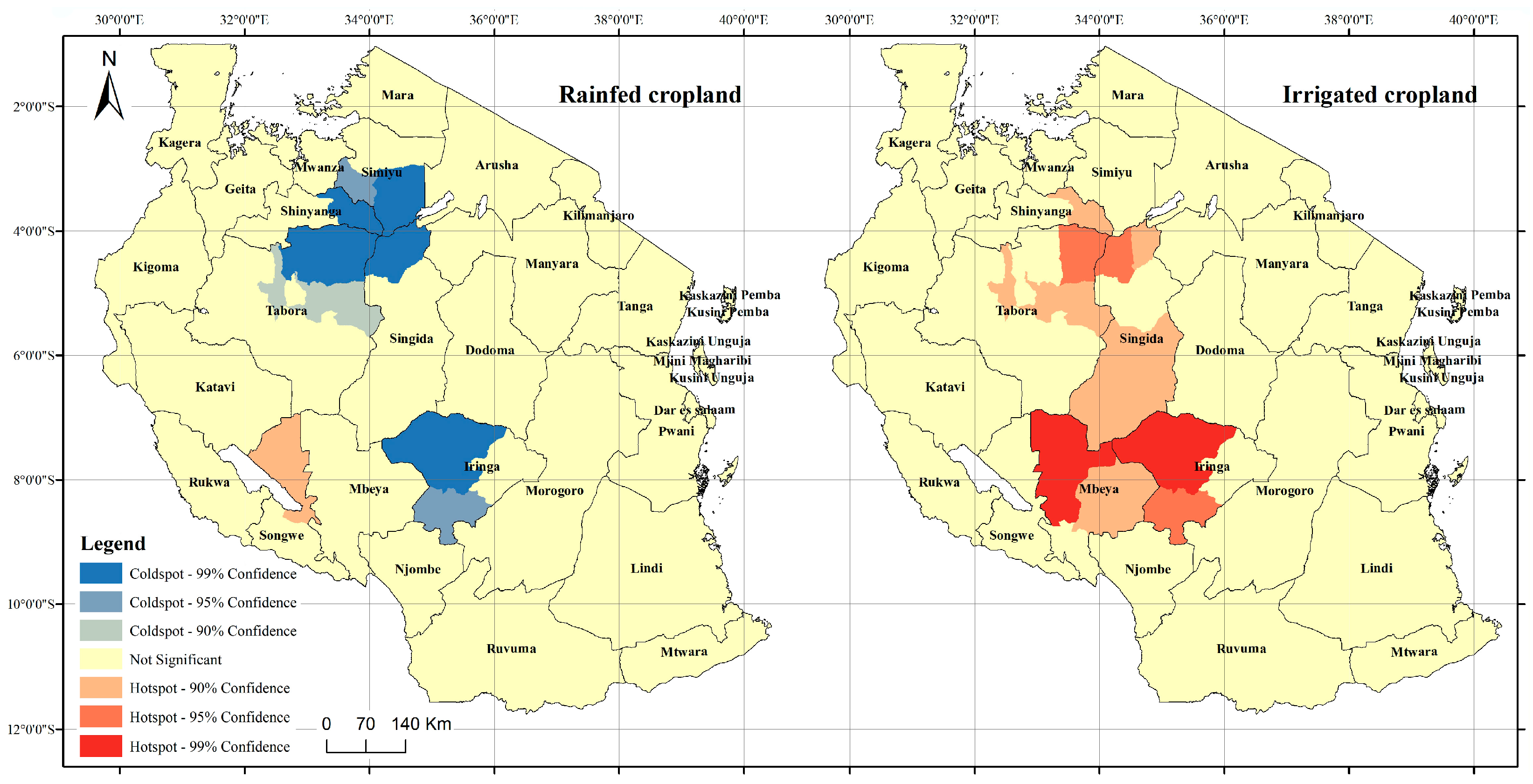
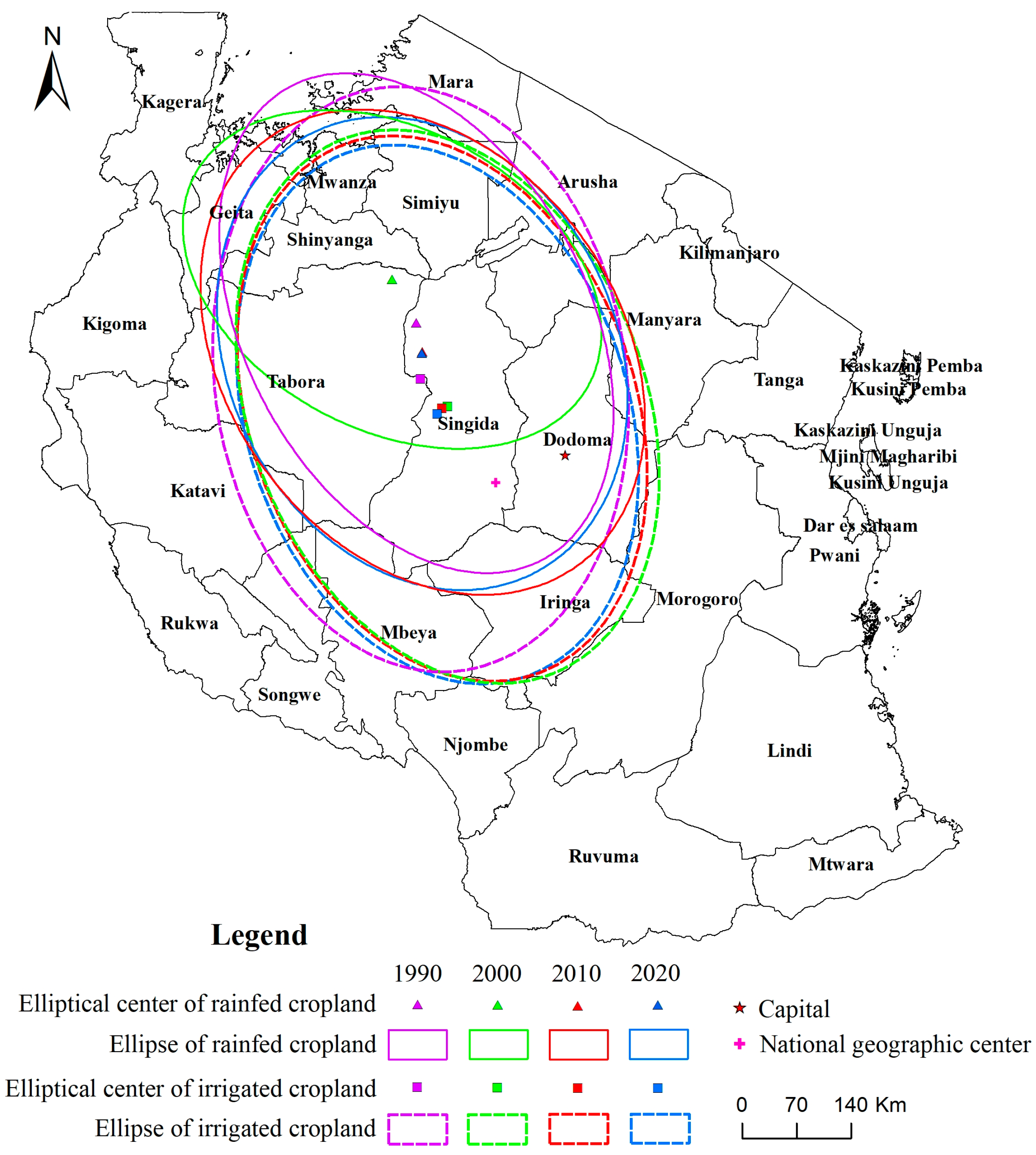
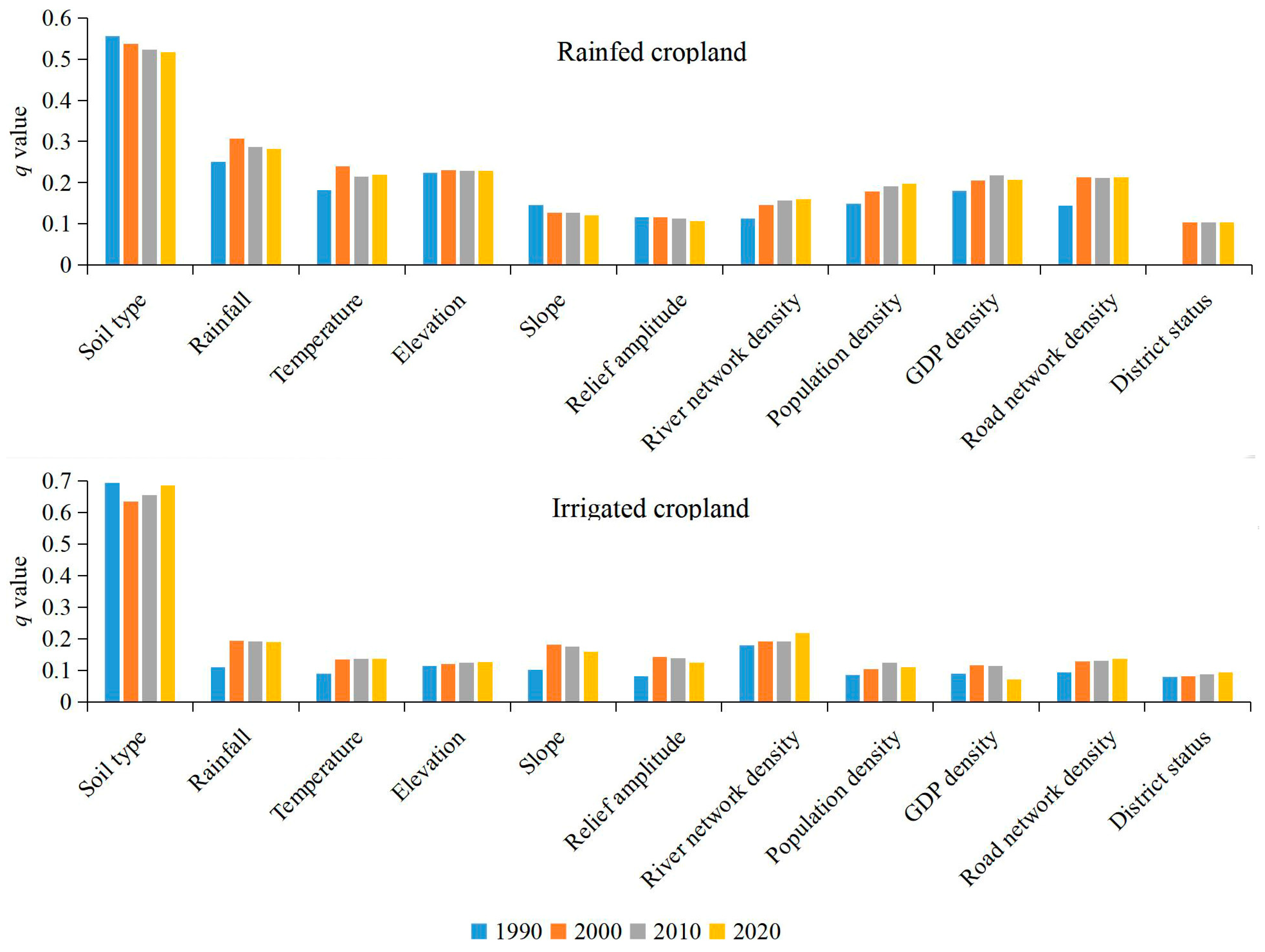
| Data Type | Data Name | Data Source | Raw Data Format |
|---|---|---|---|
| Land cover data | Land cover | https://zenodo.org/records/4280923 (accessed on 2 March 2025) | GeoTIFF |
| Natural environment data | Rainfall | https://climateknowledgeportal.worldbank.org/ (accessed on 5 March 2025) | NetCDF |
| Temperature | https://climateknowledgeportal.worldbank.org/ (accessed on 5 March 2025) | NetCDF | |
| Soil type | https://www.ilri.org/ (accessed on 10 March 2025) | Shapefile | |
| Elevation | https://earthexplorer.usgs.gov/ (accessed on 10 March 2025) | GeoTIFF | |
| River network | https://download.geofabrik.de/index.html (accessed on 15 March 2025) | Shapefile | |
| Socioeconomic data | Road network | https://download.geofabrik.de/index.html (accessed on 15 March 2025) | Shapefile |
| Population | https://ghsl.jrc.ec.europa.eu/ (accessed on 15 March 2025) | GeoTIFF | |
| GDP | https://www.nature.com/articles/s41597-022-01322-5 (accessed on 15 March 2025) | GeoTIFF | |
| Statistics data | http://www.nbs.go.tz (accessed on 18 March 2025) | CSV | |
| Administrative divisions data | Administrative divisions | http://www.nbs.go.tz (accessed on 18 March 2025) | Shapefile |
| Land Cover Types | 1990 | 2000 | 2010 | 2020 |
|---|---|---|---|---|
| Rainfed cropland | 161,185.85 | 169,491.87 | 161,735.97 | 159,665.01 |
| Irrigated cropland | 1265.67 | 15,140.69 | 17,515.74 | 20,643.70 |
| Grassland | 24,963.58 | 50,661.09 | 52,924.53 | 55,864.86 |
| Forest | 496,759.22 | 429,299.47 | 432,404.18 | 428,184.65 |
| Shrubland | 195,764.27 | 213,101.48 | 212,162.62 | 210,287.21 |
| Wetland | 7647.06 | 8271.27 | 8568.73 | 9464.35 |
| Water body | 4626.58 | 3692.80 | 3397.88 | 3111.20 |
| Impervious surfaces | 921.92 | 1141.06 | 1754.78 | 2375.52 |
| Bare land | 3076.49 | 5410.57 | 5745.86 | 6613.78 |
| 2000 | Rainfed Cropland | Irrigated Cropland | Grassland | Forest | Shrubland | Wetland | Water Body | Impervious Surfaces | Bare Land | |
|---|---|---|---|---|---|---|---|---|---|---|
| 1990 | ||||||||||
| Rainfed cropland | 98,492.83 | 6446.52 | 4380.89 | 16,810.33 | 33,444.11 | 1049.05 | 96.31 | 77.68 | 388.11 | |
| Irrigated cropland | 334.97 | 333.31 | 111.72 | 114.60 | 298.57 | 37.87 | 3.73 | 0.95 | 29.96 | |
| 2010 | Rainfed cropland | Irrigated cropland | Grassland | Forest | Shrubland | Wetland | Water body | Impervious surfaces | Bare areas | |
| 2000 | ||||||||||
| Rainfed cropland | 154,683.75 | 1698.63 | 1027.87 | 3493.36 | 7872.06 | 222.18 | 46.49 | 279.04 | 168.49 | |
| Irrigated cropland | 60.15 | 14,972.10 | 23.31 | 8.21 | 57.39 | 10.56 | 2.94 | 0.68 | 5.35 | |
| 2020 | Rainfed cropland | Irrigated cropland | Grassland | Forest | Shrubland | Wetland | Water body | Impervious surfaces | Bare areas | |
| 2010 | ||||||||||
| Rainfed cropland | 153,005.94 | 1947.21 | 1112.38 | 1174.42 | 3560.26 | 395.45 | 12.23 | 245.62 | 282.46 | |
| Irrigated cropland | 44.01 | 17,238.57 | 92.99 | 3.43 | 61.86 | 45.10 | 1.42 | 1.29 | 27.05 | |
| 2000 | Rainfed Cropland | Irrigated Cropland | 2010 | Rainfed Cropland | Irrigated Cropland | 2020 | Rainfed Cropland | Irrigated Cropland | |||
|---|---|---|---|---|---|---|---|---|---|---|---|
| 1990 | 2000 | 2010 | |||||||||
| Grassland | 704.81 | 407.72 | Grassland | 112.09 | 44.58 | Grassland | 42.23 | 70.31 | |||
| Forest | 33,648.14 | 3330.02 | Forest | 2426.71 | 154.00 | Forest | 2698.57 | 281.93 | |||
| Shrubland | 35,683.54 | 4367.29 | Shrubland | 4246.04 | 581.54 | Shrubland | 3854.90 | 1077.24 | |||
| Wetland | 363.26 | 139.60 | Wetland | 118.78 | 31.19 | Wetland | 13.28 | 10.02 | |||
| Water body | 184.02 | 65.11 | Water body | 75.50 | 30.02 | Water body | 4.90 | 16.03 | |||
| Impervious surfaces | 0 | 0 | Impervious surfaces | 0 | 0 | Impervious surfaces | 0.38 | 0.71 | |||
| Bare land | 80.30 | 51.11 | Bare land | 12.95 | 3.66 | Bare land | 0.80 | 1.68 | |||
| Year | Central Coordinates | Semi-Major Axis (km) | Semi-Minor Axis (km) | Azimuth (°) | Area (104 Km2) | Oblateness | |
|---|---|---|---|---|---|---|---|
| Rainfed cropland | 1990 | 34°3′39″, 4°36′1″ | 342.51 | 219.56 | 151.68 | 23.62 | 0.36 |
| 2000 | 33°46′44″, 4°5′41″ | 285.69 | 192.21 | 117.80 | 17.25 | 0.33 | |
| 2010 | 34°8′9″, 4°56′19″ | 337.09 | 251.59 | 143.59 | 26.64 | 0.25 | |
| 2020 | 34°7′35″, 4°56′52″ | 314.81 | 247.42 | 152.72 | 24.47 | 0.21 | |
| Irrigated cropland | 1990 | 34°6′30″, 5°14′12″ | 375.50 | 263.43 | 171.51 | 31.07 | 0.30 |
| 2000 | 34°25′19″, 5°32′47″ | 366.48 | 252.82 | 158.32 | 29.11 | 0.31 | |
| 2010 | 34°21′36″, 5°34′6″ | 359.52 | 246.57 | 159.80 | 27.85 | 0.31 | |
| 2020 | 34°18′4″, 5°38′12″ | 353.29 | 244.35 | 161.37 | 27.12 | 0.31 |
Disclaimer/Publisher’s Note: The statements, opinions and data contained in all publications are solely those of the individual author(s) and contributor(s) and not of MDPI and/or the editor(s). MDPI and/or the editor(s) disclaim responsibility for any injury to people or property resulting from any ideas, methods, instructions or products referred to in the content. |
© 2025 by the authors. Licensee MDPI, Basel, Switzerland. This article is an open access article distributed under the terms and conditions of the Creative Commons Attribution (CC BY) license (https://creativecommons.org/licenses/by/4.0/).
Share and Cite
Zhang, J.; Liu, Y.; Zhang, R.; Fan, J.; Dai, Z.; Liang, H. Research on the Spatiotemporal Evolution Characteristics and Driving Factors of Cropland in Tanzania from 1990 to 2020. Land 2025, 14, 1771. https://doi.org/10.3390/land14091771
Zhang J, Liu Y, Zhang R, Fan J, Dai Z, Liang H. Research on the Spatiotemporal Evolution Characteristics and Driving Factors of Cropland in Tanzania from 1990 to 2020. Land. 2025; 14(9):1771. https://doi.org/10.3390/land14091771
Chicago/Turabian StyleZhang, Jiaqi, Yannan Liu, Rongrong Zhang, Jiaqi Fan, Zhiming Dai, and Hui Liang. 2025. "Research on the Spatiotemporal Evolution Characteristics and Driving Factors of Cropland in Tanzania from 1990 to 2020" Land 14, no. 9: 1771. https://doi.org/10.3390/land14091771
APA StyleZhang, J., Liu, Y., Zhang, R., Fan, J., Dai, Z., & Liang, H. (2025). Research on the Spatiotemporal Evolution Characteristics and Driving Factors of Cropland in Tanzania from 1990 to 2020. Land, 14(9), 1771. https://doi.org/10.3390/land14091771






